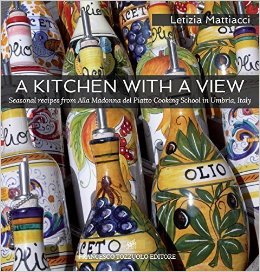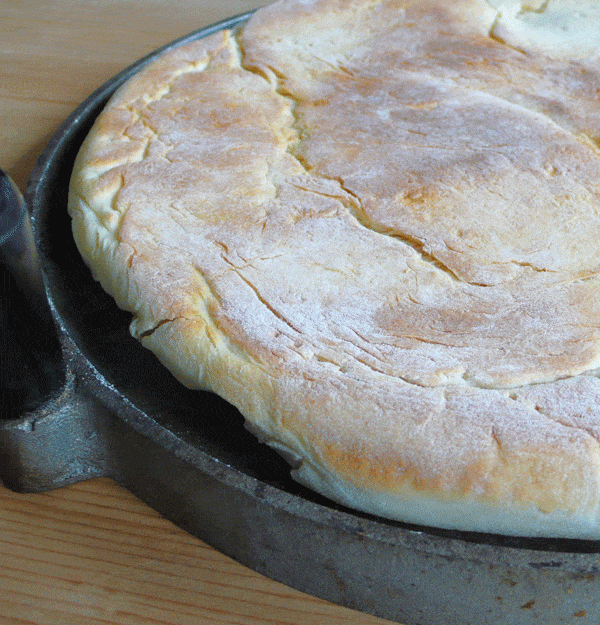Updated 2018.
The delightful and talented Letizia Mattiacci, the proprietor of the agriturismo Alla Maddonna del Piatto in Assisi, is one of the great treasures of Umbria. The small cooking school she runs made our selective list of Italy’s best cooking schools. Her guests and students have long been asking Letizia for more of her recipes and she recently complied with the lovely cookbook A Kitchen With a View. Letizia shared her recipe for the classic Umbrian dish — torta al testo:

In the past, the torta was unleavened and cooked on a stone, the “testo,” placed over hot coals in the fireplace, like a chapati. This was a practical solution to obtain fresh bread on a daily basis. Farmers only made leavened bread once or twice a fortnight, as firing a wood oven was time-consuming and more work; they needed to conserve their energy for working in the fields.
The torta al testo is still prepared in many Umbrian homes using a cast iron plate on the stove top. It is often served alongside a platter of antipasto or with chicken alla cacciatora or stuffed with our delicious prosciutto from Norcia. My version is enriched with yeast, eggs and a small amount of cheese. You can omit the cheese and eggs, if you wish, and increase the amount of water instead.
Ingredients:
1/2 teaspoon active dry yeast
2 cups plain flour or white stone-ground flour
1 egg
2 tablespoons grated Parmesan or pecorino cheese
3/4 cup water
1 teaspoon salt
1 teaspoon sugar
1 tablespoon extra-virgin olive oil
Directions:
Sprinkle the yeast over the water and stir to dissolve. In a food processor, combine the flour, cheese, olive oil, sugar and salt. Mix briefly. First add the egg and then the yeast mixture. Mix again until a soft ball of dough forms. Add a little additional warm water if the dough is still dry and does not form a ball.
Alternatively, mix the ingredients by hand in a large bowl, then turn the dough out on to a lightly floured surface and knead for about 10 minutes, adding more flour to prevent sticking, until the dough is smooth and elastic.
Place the dough in an oiled bowl and cover first with clingfilm and then with a tea towel. Leave in a draft-free place until the dough has risen and doubled in size. This will take 2-3 hours. Heat a cast iron skillet (you can also use a Mexican comal or Tava griddle) to a medium heat. Do not grease it.
Transfer the dough to a floured surface, and stretch the dough with your hands until it is about 1 cm (1/2 inch) thick. Place the flattened dough on to the skillet and pierce with a fork to prevent air bubbles.
If the dough is too soft, transfer it to the skillet first and then, with wet hands, stretch it quickly to cover the bottom of the skillet.
Cook slowly for about 45 minutes until dry and golden on both sides, turning over 3 to 4 times.
Cut into wedges and keep it in a cotton tea towel until ready to serve. Fill the wedges with cured meats or grilled sausages and cooked greens like spinach, swiss chard, chicory or rapini.
Serves 4

